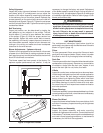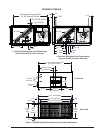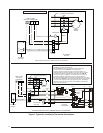
4
GENERAL INFORMATION
B5SM air handlers are shipped from the factory ready for
installation in a horizontal position. The units can be easily re-
confi gured in the fi eld for vertical applications. The return air
opening is interchangeable between the bottom of the unit and
the top panel simply by switching the fi lter-rack with the return
air cover panel. For either confi guration, suffi cient clearance
must be provided on the sides of the unit to allow access for
servicing the blower, motor, coil assembly, and fi lters.
This unit has been designed and tested for capacity and effi ciency
in accordance with A.R.I. Standards. This unit will provide many
years of safe and dependable comfort, providing it is properly
installed and maintained. With regular maintenance, this unit
will operate reliably year after year. Abuse, improper use, and/
or improper maintenance can shorten the life of the appliance
and create unsafe hazards.
Before You Install the Air Handler
This equipment is securely packed at the time of shipment and
upon arrival should be carefully inspected for damage prior
to installing the equipment at the job site. Claims for damage
(apparent or concealed) should be fi led immediately with the
carrier.
The cooling load of the area to be conditioned must be
calculated and a system of the proper capacity selected.
Check the electrical supply and verify the power supply is
adequate for unit operation. The system must be wired and
provided with circuit protection in accordance with local building
codes. If there is any question concerning the power supply,
contact the local power company.
The air handler should be installed before routing the refrigerant
tubing. Refer to the indoor unit’s installation instructions for
installation details.
Verify the air delivery of the/air handler is adequate to handle
the static pressure drop of the coil, fi lter, and duct work.
Please consult your dealer for maintenance information
and availability of maintenance contracts. Please read all
instructions before installing the unit.
Locating the Air Handler
• Survey the job site to determine the best location for mounting
the unit.
• Overhead obstructions, poorly ventilated areas, and areas
subject to accumulation of debris should be avoided.
• Consideration should be given to availability of electric power,
service access, noise, and shade.
Field Connections for Electrical Power Supply
• All wiring must comply with current provisions of the National
Electrical Code (ANSI/NFPA 70) and with applicable local
codes having jurisdiction.
• The minimum size of electrical conductors and circuit protection
must be in compliance with information listed on the outdoor
unit data label.
• Electrical power supplied to the unit must be adequate for
proper operation of the equipment. The system must be wired
and provided with circuit protection in accordance with local
building codes.
Air Ducts
This unit is designed only for use with a supply
and return duct. Air ducts should be installed in
accordance with the standards of the National Fire
Protection Association Standard for Installation of
Air Conditioning Systems (NFPA 90A), Standard for
Installation of Residence Type Warm Air Heating
and Air Conditioning Systems (NFPA 90B), and
all applicable local codes. NFPA publications are
avaialable by writing to: National Fire Protection
Association, Batterymarch Park, Quincy, ME 02269
or visit www.NFPA.org on the web.
• Design the duct work according to methods
described by the Air Conditioning Contractors
of America (ACCA).
• The return air duct must have the same free area
as the opening provided on the blower coil unit.
• Duct work should be attached directly to the unit
fl anges for horizontal and vertical applications.
See Figures 4 or 5 (pages 10 or 11).
Unconditioned Spaces
All duct work passing through unconditioned space
must be properly insulated to minimize duct losses
and prevent condensation. Use insulation with an
outer vapor barrier. Refer to local codes for insulation
material requirements.
Acoustical Duct Work
Certain installations may require the use of
acoustical lining inside the supply duct work.
• Acoustical insulation must be in accordance with
the current revision of the Sheet Metal and Air
Conditioning Contractors National Association
(SMACNA) application standard for duct liners.
• Duct lining must be UL classifi ed batts or blankets
with a fi re hazard classifi cation of FHC-25/50 or
less.
• Fiber duct work may be used in place of internal
duct liners if the fi ber duct work is in accordance
with the current revision of the SMACNA
construction standard on fi brous glass ducts.
Fibrous duct work and internal acoustical lining
must be NFPA Class 1 air ducts when tested per
UL Standard 181 for Class 1 ducts.


















